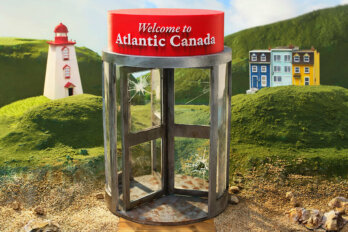It’s early September, and dozens of people are gathered outside a building in Nunavut’s capital. They form the only lineup in the city of nearly 8,000 people. On Twitter, residents jokingly warn each other to use the washroom before joining the wait, to bring a book, to dress for the crisp fall air. The mood is “jovial,” according to Kyle Sheppard, a local. Someone set up a barbecue to sell hot dogs to those standing outside. The territory’s finance minister was at the ribbon-cutting ceremony; he bought a twelve-pack of Corona.
To most people in North America, the opening of a beer and wine store is nothing special. But in Iqaluit, it’s the first instance of retail sales of alcoholic beverages in nearly fifty years. For decades, Nunavut has flirted with prohibition. All communities in the territory, apart from Iqaluit, currently have some sort of constraint on buying alcohol. In four communities, drinks have to be shipped from government-owned warehouses in Rankin Inlet or Iqaluit, or from outside the territory. In fourteen others, alcohol can be purchased only with the approval of a local committee. In the six remaining communities, possessing alcohol is prohibited. This new outlet, owned and operated by the territorial government, is an experiment in storefront sales, making Iqaluit the only community in Nunavut where residents can buy bottles and cans in town.
The Iqaluit Beer and Wine Store brings the promise of better alcohol consumption to the North: responsible drinkers will face fewer obstacles, problem drinkers will have access to beer instead of hard liquor, and money that might otherwise fund bootleggers will now go to the government. Or, at least, that’s the hope. The store, which is part of a three-year pilot project to reduce the harm of alcohol consumption, came out of a task force struck in 2010. The task force was composed of doctors, RCMP members, former politicians, and other regional representatives, and it released a report in 2012 that recommended an overhaul of Nunavut’s alcohol regulations. Three years later, in a non-binding plebiscite, Iqaluit residents voted in favour of opening a beer and wine store. More communities are sure to follow. It’s an experiment similar to what Canada is doing with marijuana—attempting to replace the black market with one that is regulated and a high-potency product with one that’s more moderate.
But not everyone is happy about the new venture. Here, the stakes are higher: multiple studies and surveys from the Government of Nunavut and the RCMP link alcohol to the territory’s crime and suicide rates, which are among the highest in Canada. In March 2016, as politicians discussed opening the store in Iqaluit, Paul Okalik, a former premier and then minister of the territory’s health and justice departments, resigned from cabinet in protest. Like some others, he believes the store will only make problems in the territory worse. The last retail alcohol store in Iqaluit closed down in the mid-seventies—then, the city was called Frobisher Bay—after a drunk man ran his snowmobile into a six-year-old boy. “I’ve buried many people,” Mike Gardner, a retired Anglican minister in Iqaluit, said at a public meeting about alcohol sales in 2014. “And the old graveyard would be not even half full—I doubt it’d be a quarter full—if there had been no booze.”
The people living in what is now Nunavut have witnessed a tremendous amount of change over the past century. In the early 1900s, interaction between those living in the region and the Canadian government was irregular. But federal politicians slowly became more and more involved. Not long ago, hunting was the only reliable food source for most Inuit families; now, they can shop at the local grocery store. Food caches dug into permafrost or stashed under piles of rocks are now electric freezers. Igloos insulated by snow and heated with an oil lamp are now houses with furnaces or boiler systems. Dog teams are now snowmobiles or trucks.
These transformations have often not been gentle. A variety of government policies in the Northwest Territories—from which Nunavut separated in 1999—in the 1950s, ’60s, and ’70s discouraged the traditional seasonal migration of Indigenous peoples and placed families into newly formed communities close to government services. There are stories of the RCMP slaughtering sled dogs to keep residents in place. The federal government scooped up groups of Inuit from northern Quebec and dropped them at the top of the Arctic Archipelago so the country would have a northern presence. Residential schools separated families and decimated traditional culture. Tuberculosis plagued the area in the 1940s and ’50s, too, and the illness is still present at the highest rates in the country. There are Inuit elders today who remember these experiences, and others have heard stories from their parents. Nunavut’s residents are dealing with historical problems and trauma in a territory that has inadequate housing, limited mental health services, and high rates of unemployment.
Throughout the liquor task force’s travels around Nunavut, people at public meetings cited loss of culture and identity as a cause for alcoholism. Addictions counsellors and social workers pointed to the territory’s high rates of crime and sexual abuse and called alcohol the drug of choice for many victims; they also highlighted the lack of employment options and a perceived general lack of direction among youth. “We feel sorry for our young people,” reads the task force’s report, quoting one anonymous elder from a community where alcohol is prohibited. “They do not know who they are.”
View Prohibition of alcohol in Nunavut in a full screen map
This context brings new weight to an age-old debate about prohibition as a means to curtail intoxication. Nunavut today is a markedly different place than the United States in the early 1900s—where, in the wake of the Industrial Revolution, opposition to the country’s drinking culture came from religious groups and white nationalists, among others. Prohibition was in force nationwide from 1920 to 1933. In the eighty-four years since alcohol was reintroduced, numerous studies have shown that strict policies do not eliminate the appetite for drinking.
Instead, according to research gathered by the US government, a host of other issues emerge: higher drug-addiction rates, a switch from beer to spirits in black-market sales, and spikes in violent crime. But experts have never reached absolute consensus. One National Institutes of Health research paper from 2006, for instance, argues that deaths from liver cirrhosis declined steeply during Prohibition in the US, as did arrests for public drunkenness. For decades after Prohibition ended, its tempering effects remained: alcohol consumption didn’t reach pre-prohibition levels until the 1970s, forty years later.
According to the Nunavut task force’s report, dry communities in Nunavut experience less alcohol-related crime than wet communities. But alcohol abuse has not disappeared. Nearly 95 percent of incidents in the territory involving the RCMP are related to alcohol. An analysis of 1,300 criminal records from the Baffin Correctional Centre showed that 90 to 95 percent of those crimes, too, happened while the perpetrator was drunk. James Morton, a criminal defence lawyer who’s worked in Nunavut for ten years says that usually the problem is binge drinking—the quick consumption of hard liquor. Morton spoke of a case just the day before in which his client and a friend had each consumed a bottle of whisky over the course of a day. “So he was drinking forty ounces of whiskey in eight hours. And that’s not uncommon.”
The task force’s report cites experts from all around the territory who say that a healthy drinking culture—one that encourages a simple glass of wine or can of beer with dinner—doesn’t exist in Nunavut. In communities where alcohol is prohibited, many young people are introduced to alcohol through the black market. But in new proposed retail stores, customers will need to register for an account and show an ID for every purchase. There will also be daily limits on how much someone can buy. A similar system was implemented in Greenland within the last decade, and after a temporary surge in alcohol-related crime, consumption has gone down.
In Cambridge Bay—the regional centre of Nunavut’s western Kitikmeot region—elder Harry Maksagak says he can walk down the street and easily identify the bootleggers and the drug dealers. Though the hamlet of 1,800 people doesn’t host a single liquor, beer, or wine store, “everything is very accessible very quickly,” Maksagak says. The community isn’t completely dry: alcohol can be ordered in. But that takes days and costs much more than store prices. A bottle of vodka valued at $40 in Toronto costs close to $140 here. Bootleggers—who legally order liquor or smuggle it in from outside the territory—offer instant purchase at an even higher price. Walk down the street in Cambridge Bay, and you could buy the same bottle of vodka from a black-market vendor for $350.
Cambridge Bay voted to approve its own retail store this May, though plans haven’t yet been finalized. With five children, twenty-eight grandchildren, four great-grandchildren, and a weekly newspaper column, Maksagak is respected in town—he’s someone people come to for advice. Before the vote, he told friends and neighbours that he supports taking money out of the hands of bootleggers. “But when I voted, I voted against it,” Magsagak says.
He is concerned about the lack of treatment facilities or counselling services in Cambridge Bay. For him, alcohol addiction is a mental health problem, which can’t be solved with a new retail store. Friends and neighbours who are inebriated or in distress regularly call Magsagak, asking for advice. He urges them to seek help—there are limited resources in the various communities, such as helplines, social workers, and local addictions groups. Magsagak would like to see an alcohol-addiction treatment centre established in each of the three regions of Nunavut, and many quoted in the report agree with him: access to alcohol should be paired with access to treatment.
A treatment centre existed in Iqaluit before Nunavut separated from the Northwest Territories in 1999, and it closed down that same year. “It wasn’t very well used. It wasn’t supported by the people,” says Keith Peterson, Nunavut’s finance minister and the person who presided over the opening of the beer and wine store. “Maybe there was a bit of a stigma.” He thinks it’s best left to communities to create their own programs, with financial support from the territorial government. Right now, any revenue from alcohol sales goes into a revolving fund that pays for inventory and education campaigns, among other things. But there are no provisions for how much of that money should be allocated to specific initiatives—and according to the task force’s report, people are frustrated with the lack of specifics in the budget. In the current plan, no money is being allocated to building a brick-and-mortar treatment centre.
One week after Iqaluit’s store opened, the RCMP sent out a press release: there was no increase in calls for service that weekend “despite the tremendous popularity of the store.” According to the department of finance, the Government of Nunavut sold $100,000 worth of beer and wine during the first weekend. It’s an experiment in its very early days. “I think it’s something that we have to look back at in two or three years,” Morton says. “If things get bad, then we get rid of it.”
That seems to be the attitude among optimists in Nunavut—a reserved hope that deregulation will work. Despite the work done by the task force, the effects on Nunavut’s drinking culture are hard to predict. As with the pending legalization of marijuana at the national level, many people in the territory are uncomfortable with the idea of more accessible intoxicants, but they also see the futility in trying to maintain prohibition. Nunavut recently elected a new government, and it will have to decide out how to move forward with changes to alcohol regulation. Prohibition won’t stamp out alcohol abuse and opening the gates to access won’t either. But normalization might foster a curiosity about why so many of us fall into alcoholism—and maybe asking that question enough times will help people find answers.






